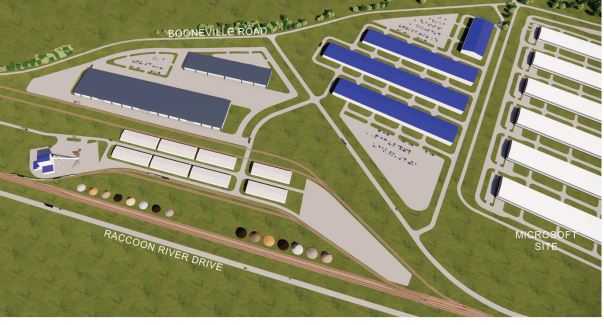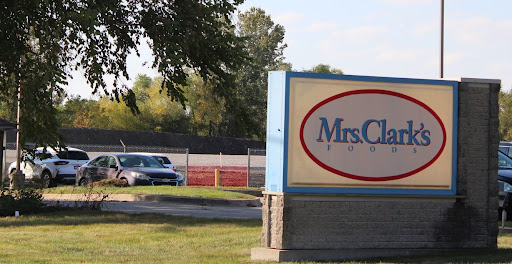Development of transload facility on land in Dallas County under consideration by owners of 230-acre tract

KATHY A. BOLTEN May 3, 2022 | 11:27 pm
3 min read time
702 wordsAll Latest News, Real Estate and DevelopmentOwners of about 230 acres between Booneville Road and Raccoon River Drive in unincorporated Dallas County are exploring development of a transload facility on the site. The development would include spaces for a manufacturing facility. The rendering above shows an example of how the site, immediately west of a Microsoft datacenter development, could be developed. Rendering courtesy city of West Des Moines
Owners of about 230 acres wedged between Booneville Road and Raccoon River Drive in Dallas County are exploring development of a transload facility that could serve an adjacent data center, grain cooperative, mining operation and other area businesses, members of a West Des Moines City Council subcommittee learned this week.
The site, which is adjacent to West Des Moines’ western border, is also large enough to support a manufacturing facility that would have access to the transload operation, Misty Wittern Lee, whose family has owned the ground for more than 50 years, told the council’s development and planning subcommittee.
Des Moines Industrial’s rail-based transload facility at 200 E. 15th St. in Des Moines began operating in February. It is the only U.S. rail-enabled transloading facility that connects to four railroads: BNSF Railway Co., Norfolk Southern Railway, Union Pacific Railway and the regional Iowa Interstate Railroad. The $25 million project, developed on about 40 acres, includes a recently completed 115,000-square-foot warehouse.
Misty Wittern Lee is part of the family that operates the Wittern Group, a 90-year-old Des Moines-area company with strong ties to the automated dispensing industry. One of its companies is Fawn Engineering that designs and develops vending machines.
Wittern Lee also owns and operate Legacy Materials, located at 35740 Ute Court, south of the site for the proposed transload development. Legacy Materials mines sand, gravel and aggregate materials that it trucks to customers. The company would likely be a customer of the transload facility, she said.
The nearby Heartland Co-op and Microsoft data center also are interested in development of a transload facility, Wittern Lee told the subcommittee.
The residential development of Napa Valley is located to the north and west of the proposed development site. Wittern Lee said she has not discussed the prosed development with Napa Valley residents.
Jessica Spoden, West Des Moines’ assistant city attorney, cautioned the landowners about developing a project that could be conceived as a nuisance. If city officials supported a development that caused an increase in noise, dust, odors or other elements that prevent nearby residents from enjoying their properties, the city could face legal challenges, Spoden said.
Protections would likely need to be put in place that limit when trains came and went, where buildings were placed on the property and the types of manufacturers that would be allowed to locate a facility on the site, she said.
“[We don’t want to] enhance any sort of nuisance type elements,” Spoden said.
No issues were discussed involving the amount of truck traffic a transload facility would generate in the area.
Wittern Lee and Lee said the proposed facility would differ from the one in Des Moines.
“That facility is [smaller] and is basically a warehouse next to a set of tracks,” Lee said. “This lends itself to opportunities beyond that, not just the warehousing and storage of materials. … This is completely different because of its size and magnitude.”
Council members Renee Hardman and Matt McKinney both said they needed more information before deciding whether to support the proposed development. Issues related to noise, light and infrastructure to the development need to be addressed, they said. Also, they said, they would need assurances that manufacturers that located on the site would not be involved with the use of hazardous or flammable materials.
“I will certainly keep an open mind,” McKinney said. “I do want to understand what sort of protections will be put in place to reduce [potential nuisance] items.”










